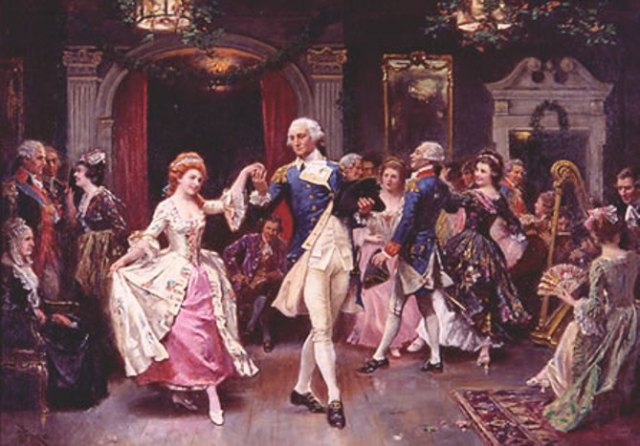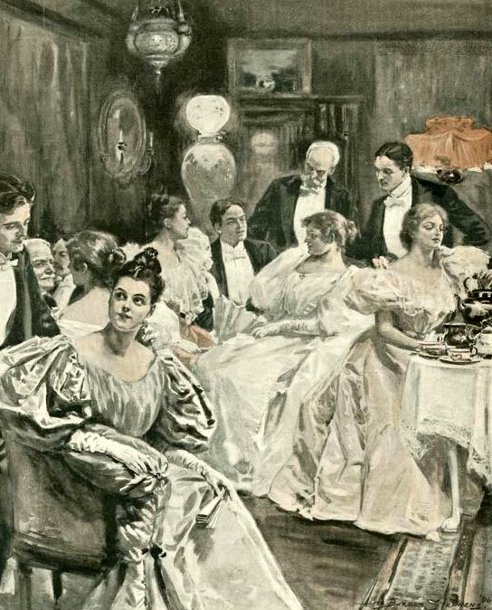Notable in the social life of America’s upper class is the series of events that lead to the annual debutante balls, a custom with roots in Old Regime pageantry.
The debut ritual involves a long and arduous process that prepares new generations for the social exigencies of the traditional upper-class lifestyle. The debut itself is only the final step on a long road, a whole education in etiquette, bearing, and good manners that begins quite early, even in infancy, and continues through a girl’s youth and adolescence until she reaches the age to qualify as a subdebutante. This is followed by the traditional “coming out” into society life. At some balls the custom has been established of inviting members of the European nobility to receive the debutantes into society. [G. William] Domhoff comments:
“The debutante season is a series of parties, teas, and dances, culminating in one or more grand balls. It announces the arrival of young women of the upper class into adult society with the utmost of formality and elegance. These highly expensive rituals, in which great attention is lavished on every detail of the food, decorations, and entertainment, have a long history in the upper class. Making their appearance in Philadelphia in 1748 and Charleston, South Carolina, in 1762, they vary only slightly from city to city across the country.”(1)
Describing the social function of this ball, [E. Digby] Baltzell affirms that it is “a rite de passage which functions to introduce the post-adolescent into the upper-class adult world, and to insure upper-class endogamy as a normative pattern of behavior.”(2)
In 1960, Lucy Kavaler listed 155 debutante balls in 31 states, all modeled after the balls of New York, Philadelphia, Charleston, and Baltimore. Kavaler described their inestimable social significance: “To millions of Americans the debut stands as the ultimate in social recognition. Today, presentation at one of the major debutante balls has come to be the criterion by which a girl becomes known as a member of society. And this acceptance carries over to her family as well.”(3)
Charleston’s St. Cecilia Society provides an example of this. Founded in 1737 as a concert society, this group holds an annual ball that only its members and special guests may attend. The full list of prerequisites for admission of new members has never been published; however, they are known to be very strict. Traditionally, neither actors nor actresses were permitted to attend the ball; this prohibition also held for divorced and remarried people. A member’s daughter who marries a non-member may still be present at the ball, but she cannot be accompanied by her husband or children.(4)
The Philadelphia Assembly, first held in 1748, has been ranked among the most aristocratic balls in the United States, and it always gathered the best of Philadelphia’s upper society. Historian Nathaniel Burt states:
“[The] Philadelphia Assembly…is probably still the most august of America’s social occasions…. Admission to the Assembly is, or is supposed to be, strictly hereditary in the male line. That is, sons and daughters of members are eligible, though not automatically, when they reach a proper age. If a daughter marries out of the Assembly, she stays out. A son however can marry anybody and stay in.”(5)
The 1793 assembly was held in George Washington’s honor, giving rise to one of the Assembly’s longstanding traditions: a toast to the Father of our Country.
In Baltimore, soon after the war of 1812, when the city’s great patrician families were at their apex, the Bachelors Cotillon was born, an annual affair directed by the men of the city’s most traditional circles. The Bachelors Cottilon—one of the country’s oldest debutante balls—has been a model for similar cotillions in other cities and states.
 In New York, the social affairs of the city form a kind of pyramid structure at whose peak are the most exclusive social events of the old families, while the less elevated levels in the upper class have their own balls. In addition to the New York families of the “Old Guard” who stage their own exclusive balls for the presentation of debutantes, some of the patriotic and hereditary associations, such as the Saint Nicholas Society of the City of New York and the General Society of Mayflower Descendants, present members or members’ daughters at annual balls and dinners.
In New York, the social affairs of the city form a kind of pyramid structure at whose peak are the most exclusive social events of the old families, while the less elevated levels in the upper class have their own balls. In addition to the New York families of the “Old Guard” who stage their own exclusive balls for the presentation of debutantes, some of the patriotic and hereditary associations, such as the Saint Nicholas Society of the City of New York and the General Society of Mayflower Descendants, present members or members’ daughters at annual balls and dinners.
Balls promoted by similar associations revolve around the traditional elites of each region and highlight the social life of many cities like Atlanta, Fort Worth, St. Louis, New Orleans, Los Angeles, and Chicago.
(1) G. William Domhoff, Who Rules America Now? A View for the 80’s (New York: Simon & Schuster, 1983), p. 32.
(2) E. Digby Baltzell, Philadelphia Gentlemen: The Making of a National Upper Class (New York: The Free Press, 1966), p. 60.
(3) Lucy Kavaler, The Private World of High Society (New York: David McKay Co., 1960), pp. 131-132.
(4) Cf. Cleveland Amory, Who Killed Society? (New York: Harper & Bros. 1960), pp. 90-91, and Stephen Birmingham, America’s Secret Aristocracy (Boston: Little, Brown and Company, 1987), pp. 149-152.
(5) Nathaniel Burt, The Perennial Philadelphians: The Anatomy of an American Aristocracy (Boston: Little, Brown & Company, 1963), pp. 95, 278.
Plinio Corrêa de Oliveira, Nobility and Analogous Traditional Elites in the Allocutions of Pius XII: A Theme Illuminating American Social History (York, Penn.: The American Society for the Defense of Tradition, Family, and Property, 1993), Appendix I, pp. 324-326.














